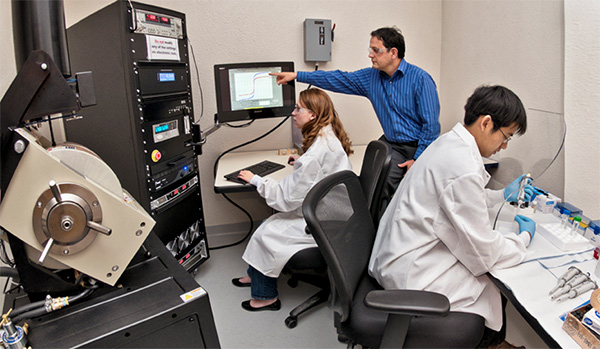Bureau Awarded $1.5 Million to Further Research into Remote Monitoring of Hydraulically Fractured Networks

Geology students Krystal Heibel and William Luu work with Mohsen Ahmadian (standing) on the Vibrating Sample Magnetometer to characterize electromagnetically active proppants.
The Bureau of Economic Geology has just been awarded a $1.5 million grant by the U.S. Department of Energy (DOE) to build on previous research by its Advanced Energy Consortium (AEC) into real-time remote monitoring of hydraulically fractured networks. The goal of the funded project is to create a more efficient and accurate process to characterize the subsurface in real time following hydraulic-fracturing operations.
Hydraulic fracturing has evolved into a sophisticated multistep process that differs from well to well. Operations use varying flow rates, fluids, and proppant amounts and sizes. Current tools, such as microseismic and tiltmeter monitoring, can provide information on fracture extent but provide little or no information on the movement and final distribution of proppants or production fluids.
AEC project manager Dr. Mohsen Ahmadian and his team will build on previous AEC-sponsored research at the Bureau’s Devine, Texas, Intermediate Scale Field Test Lab to address the DOE’s interest in hydraulic-fracture mapping and characterization. Ahmadian reports that the goals of the project are threefold: investigate the feasibility of using electromagnetically active proppants (EAP) to demonstrate remote monitoring of relative changes in subsurface geochemistry and pore pressure; advance development of electromagnetic imaging tools to achieve the first objective in near real time; and assess a multiphysics joint inversion package for prediction of changes in flow patterns and physiochemical changes within an EAP-filled hydraulic-fracture network.
This DOE-funded project is expected to prove the feasibility of a near–real time electromagnetic mapping technique for remote monitoring of relative changes in geochemistry and pore pressure. The methods developed and demonstrated during this study will lead to a better understanding of the extent of proppant-filled fracture networks, the stress state of formations, fluid leak-off and invasion, and the characterization of engineered fracture systems in near real time—all critical data for the efficient production of hydraulically fractured reservoirs.
The comprehensive data set collected in this study will be disseminated to the public and will lay the foundation for the advancement of additional geophysical fracture mapping and modeling techniques. After results are analyzed, the team hopes to make the Intermediate Scale Field Test Lab available as a benchmarked field lab, and to collaborate with other scientists interested in this research.